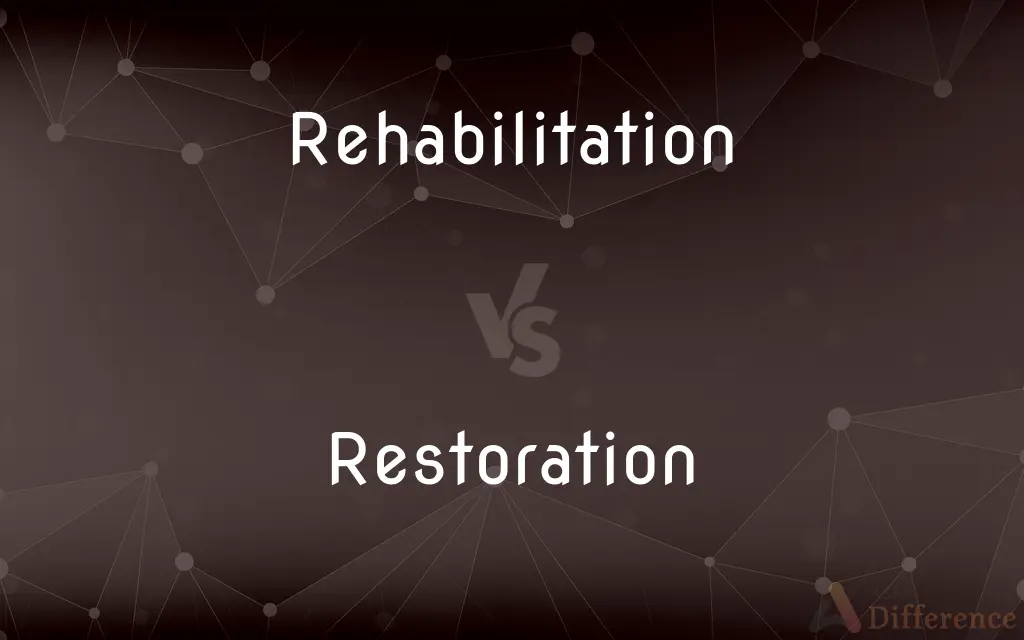Rehabilitation vs. Restoration — What's the Difference?
By Fiza Rafique & Maham Liaqat — Updated on March 16, 2024
Rehabilitation focuses on improving function or conditions to a useful state, whereas restoration aims to return something to its original condition.

Difference Between Rehabilitation and Restoration
Table of Contents
ADVERTISEMENT
Key Differences
Rehabilitation involves modifying or adapting something to improve its condition or functionality, often making it suitable for new purposes. It emphasizes the practical aspects of use and may incorporate contemporary standards and materials. Rehabilitation is commonly applied in medical, ecological, and architectural contexts, aiming to enhance utility while acknowledging and respecting historical or original aspects.
Restoration, on the other hand, seeks to return an item, structure, or ecosystem to its original state, often using period-appropriate materials and techniques. This process emphasizes historical accuracy and the preservation of original designs and materials. Restoration efforts are driven by the desire to preserve the authenticity and integrity of the original subject, making it a key practice in heritage conservation and environmental management.
While rehabilitation may involve significant alterations to improve functionality or adapt to new uses, restoration focuses on conserving and repairing existing elements to accurately reflect the subject's original condition. For example, in architecture, rehabilitation might include updating a historic building with modern amenities for current use, whereas restoration would strive to preserve its original design and materials.
In environmental contexts, rehabilitation aims to improve ecosystem health and resilience, possibly introducing new species or elements to enhance functionality. Conversely, ecological restoration attempts to replicate historical conditions before human impact, often requiring the removal of invasive species and reintroduction of native flora and fauna to achieve pre-disturbance states.
The goals of rehabilitation and restoration differ significantly; rehabilitation is primarily concerned with enhancing usability and adapting to current needs, while restoration aims to preserve historical or natural authenticity. These differing objectives influence the methods and materials used in each approach, reflecting a balance between practicality and preservation.
ADVERTISEMENT
Comparison Chart
Objective
Improve condition or functionality for current use.
Return to original, historical condition.
Approach
May involve modern materials and alterations.
Uses period-appropriate materials and techniques.
Focus
Usability and adaptation to new purposes.
Historical accuracy and preservation of originality.
Application
Architecture, medicine, ecology.
Heritage conservation, environmental management.
Outcome
Functional and suitable for contemporary needs.
Authentic and reflective of original state.
Compare with Definitions
Rehabilitation
Can apply to various contexts, including ecological and urban.
Wetland rehabilitation focuses on enhancing water quality and biodiversity.
Restoration
Seeks to preserve authenticity and integrity.
The castle's restoration was carefully planned to maintain its historical significance.
Rehabilitation
Often involves modernization or adjustments.
After his injury, his rehabilitation process included physical therapy to regain mobility.
Restoration
Involves detailed research and period-appropriate techniques.
The museum's restoration of the ancient artifact included analyzing original paint residues.
Rehabilitation
Aims for practicality and contemporary relevance.
Rehabilitation projects might update buildings with energy-efficient systems.
Restoration
Returning something to its original, historical state.
The restoration of the Victorian home involved using authentic materials from the era.
Rehabilitation
Emphasizes improving conditions within current contexts.
Rehabilitation of historical districts often introduces new infrastructures while preserving aesthetic values.
Restoration
Essential in heritage conservation and environmental management.
Forest restoration projects aim to revert ecosystems to their pre-disturbance conditions.
Rehabilitation
Improving function or adaptability for new uses.
The rehabilitation of the old factory included adding modern offices and accessibility features.
Restoration
Prioritizes historical accuracy and original designs.
Art restoration requires meticulous work to preserve the original artist’s intention.
Rehabilitation
To restore to good health or useful life, as through therapy and education
Rehabilitate a patient.
Rehabilitate a prison inmate.
Restoration
An act of restoring
Damage too great for restoration.
Rehabilitation
To restore to good condition
Rehabilitate a storefront.
Rehabilitate the economy.
Restoration
An instance of restoring or of being restored
Restoration of the sculpture was expensive.
Rehabilitation
To cause to be regarded again in a positive way; reestablish esteem for
Rehabilitate a reputation.
Rehabilitate a forgotten poet.
Restoration
The state of being restored.
Rehabilitation
To restore the former rank, privileges, or rights of
Under the new regime, party members who had been sent to prison were rehabilitated.
Restoration
Something, such as a renovated building, that has been restored.
Rehabilitation
The process of rehabilitating somebody or something.
Restoration
The return of a constitutional monarchy to Great Britain in 1660 under Charles II.
Rehabilitation
The act of rehabilitating, or the state of being rehabilitated.
Restoration
The period between the crowning of Charles II and the Revolution of 1688.
Rehabilitation
The restoration of someone to a useful place in society
Restoration
The process of bringing an object back to its original state; the process of restoring something.
Foreskin restoration
The restoration of this painting will take years.
The restoration of this medieval church involved undoing all the Victorian modifications.
Rehabilitation
The conversion of wasteland into land suitable for use of habitation or cultivation
Restoration
(theology) The receiving of a sinner to divine favor.
Rehabilitation
Vindication of a person's character and the re-establishment of that person's reputation
Restoration
The act of restoring or bringing back to a former place, station, or condition; the fact of being restored; renewal; reëstablishment; as, the restoration of friendship between enemies; the restoration of peace after war.
Behold the different climes agree,Rejoicing in thy restoration.
Rehabilitation
The treatment of physical disabilities by massage and electrotherapy and exercises
Restoration
The state of being restored; recovery of health, strength, etc.; as, restoration from sickness.
Restoration
That which is restored or renewed.
Restoration
The reign of Charles II in England; 1660-1685
Restoration
The act of restoring something or someone to a satisfactory state
Restoration
Getting something back again;
Upon the restitution of the book to its rightful owner the child was given a tongue lashing
Restoration
The state of being restored to its former good condition;
The inn was a renovation of a Colonial house
Restoration
Some artifact that has been restored or reconstructed;
The restoration looked exactly like the original
Restoration
A model that represents the landscape of a former geological age or that represents and extinct animal etc.
Restoration
The re-establishment of the British monarchy in 1660
Common Curiosities
What is restoration?
Restoration aims to return something to its original, historical state, emphasizing authenticity and historical accuracy.
Can rehabilitation involve modern materials and techniques?
Yes, rehabilitation often incorporates modern materials and techniques to enhance functionality and adaptability.
Why is restoration important in heritage conservation?
Restoration is crucial in heritage conservation to preserve the authenticity, integrity, and historical significance of cultural artifacts and structures.
What does restoration involve in environmental management?
In environmental management, restoration involves returning ecosystems to their original state, often requiring the removal of invasive species and reintroduction of native ones.
What is rehabilitation?
Rehabilitation involves modifying or improving something to make it functional or suitable for contemporary use.
What is the significance of rehabilitation in healthcare?
In healthcare, rehabilitation helps individuals recover from injuries or conditions, focusing on regaining strength, mobility, and functionality.
How do rehabilitation and restoration differ in their objectives?
Rehabilitation focuses on functionality and adaptation for current needs, while restoration seeks to preserve originality and historical integrity.
What are the common applications of rehabilitation?
Rehabilitation is commonly applied in medical therapy, ecological management, and the adaptation of buildings for new uses.
How do approaches differ between rehabilitation and restoration in architecture?
In architecture, rehabilitation might include adding modern amenities for usability, whereas restoration focuses on preserving original designs and materials.
Can rehabilitation change the original purpose of a structure?
Yes, rehabilitation can change a structure's original purpose to suit contemporary needs and functionalities.
Can restoration use new materials?
Restoration efforts prioritize using period-appropriate materials, but sometimes, new materials are used if they closely mimic the original.
Why might someone choose rehabilitation over restoration?
Someone might choose rehabilitation over restoration to adapt a structure or ecosystem to current needs and conditions while still respecting its historical or ecological significance.
Is ecological restoration always possible?
Ecological restoration aims to return ecosystems to their original states, but complete restoration may not always be possible due to extensive changes or irreversible damage.
How does rehabilitation affect historical buildings?
Rehabilitation of historical buildings aims to make them functional and relevant for contemporary use while respecting their historical significance.
What challenges are faced in restoration projects?
Restoration projects face challenges such as sourcing authentic materials, maintaining historical accuracy, and the technical difficulties of preserving aged structures.
Share Your Discovery

Previous Comparison
Me vs. Mine
Next Comparison
Linguistics vs. PhilologyAuthor Spotlight
Written by
Fiza RafiqueFiza Rafique is a skilled content writer at AskDifference.com, where she meticulously refines and enhances written pieces. Drawing from her vast editorial expertise, Fiza ensures clarity, accuracy, and precision in every article. Passionate about language, she continually seeks to elevate the quality of content for readers worldwide.
Co-written by
Maham Liaqat















































